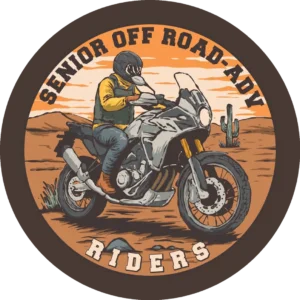6 Pro Tips Guaranteed to Make You a Better Off-Road Rider
Pro Techniques You Need to Know
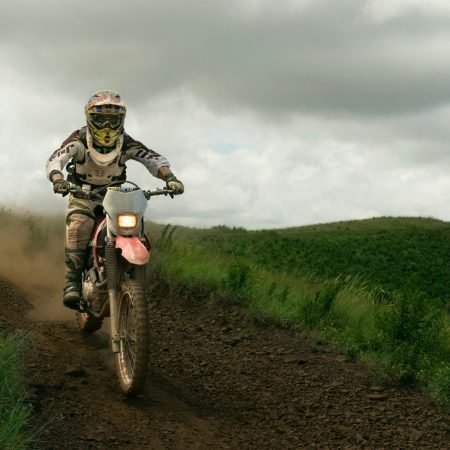
If you’ve spent years on street bikes, you already have a solid feel for traction, cornering, and braking on predictable pavement. But moving onto dirt and gravel throws a whole new set of challenges your way. Even riders with thousands of miles behind them can feel out of their element when every surface keeps changing and body position matters more than ever.
Here are six pro-level techniques you can start putting to use right away. These insights come from seasoned adventure riders and coaches who know what it takes to stay in control when the pavement runs out. Whether you’re planning your first backcountry trip or just want to sharpen your skills, you’ll find these tips make a real difference in your riding.

Stand on the Pegs and Stay Loose
Most street riders stay seated almost all the time, but off-road, your legs are your main suspension. Standing changes how you handle the bike. It lowers your effective center of gravity, absorbs impacts, and lets the motorcycle move beneath you rather than bouncing you around.
When you stand, keep a slight bend in your knees and relax your hips. Your weight should stay balanced over the pegs, not shifted too far back or pitched forward over the bars. That way, the bike can pivot and react to uneven ground while you stay steady.
Practice Drill: Find a dirt road and ride slowly while standing. Focus on keeping your arms loose and letting your knees and ankles soak up bumps. As you get comfortable, tackle rougher sections while staying light on the bars.
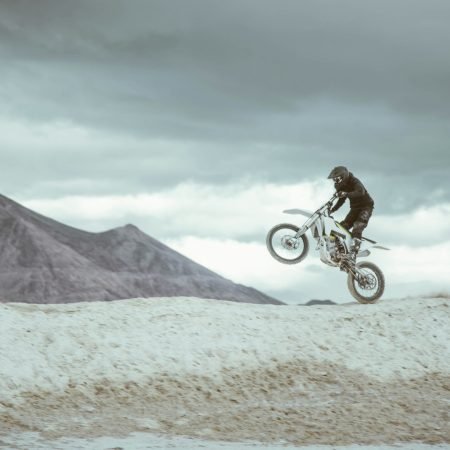
Smooth Out Your Throttle and Clutch
On the road, you can get away with snapping the throttle open. On loose surfaces, that same habit usually ends in an unexpected slide. Skilled dirt riders learn to be smooth and deliberate with their throttle and clutch inputs.
When traction is unpredictable, feathering the clutch helps you deliver exactly the power you need without overwhelming the rear tire. Instead of jerking the throttle, roll it on gently and be ready to ease off if you feel the rear starting to drift. If you do break traction, don’t chop the throttle, adjust smoothly instead.
Practice Drill: In a wide open area, practice easing the throttle on until the rear starts to slip, then hold it steady. Get comfortable with that sensation so it doesn’t catch you off guard.
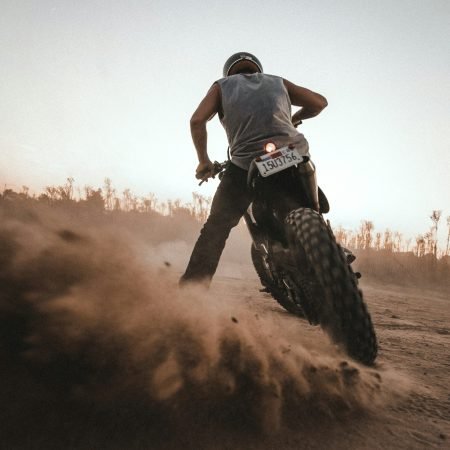
Steer with the Rear Wheel
Off-road, the rear wheel isn’t just there to push you forward, it also helps you steer. Subtle throttle changes can tighten or widen your line through a corner. Many experienced riders will deliberately let the rear drift just a bit to help the bike pivot through a turn.
As you enter a corner, apply steady throttle and then roll it on a little more to start a slight drift. It doesn’t need to be dramatic, just enough to point the bike where you want it to go. Keep your upper body relaxed to avoid fighting the movement.
Practice Drill: On a gentle dirt curve, ride in standing position and practice gradually adding throttle to feel how the rear guides your line.
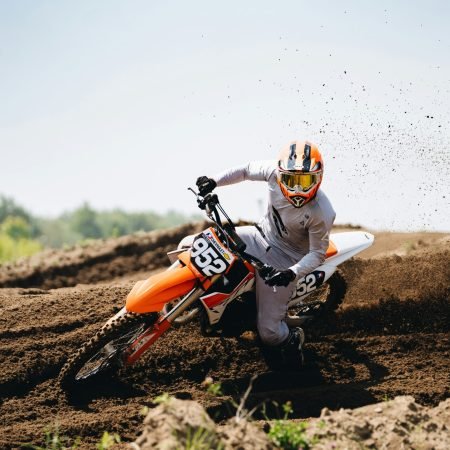
Look Further Down the Trail
Target fixation trips up a lot of riders new to dirt. If you lock your eyes on a big rock or a rut, odds are you’ll hit it. One of the simplest and most effective habits is learning to look well ahead, where you actually want to go.
Your vision steers the bike. Off-road, this skill becomes essential because you need to plan your line before obstacles are under your front wheel. As you approach rough sections, glance briefly to register them, then return your focus farther down the trail.
Practice Drill: On a trail with scattered obstacles, pick your path and keep your eyes 15–20 feet ahead. Consciously avoid staring at hazards as you pass over them.
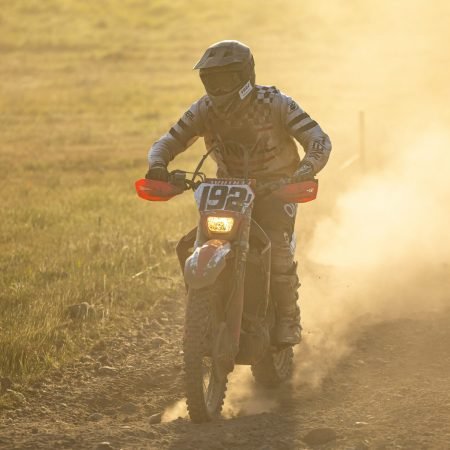
Use More Rear Brake Than You’re Used To
On pavement, most of your stopping power comes from the front brake. Off-road, it often works the other way around. The rear brake helps you slow down smoothly without washing out the front tire on loose ground.
A lot of riders find that modulating the rear brake while standing keeps the bike composed and predictable. The front brake still has a role, but it takes a lighter touch when traction is limited.
Practice Drill: On a flat dirt section, practice slowing down with only the rear brake to get a feel for how it behaves. Then combine both brakes with about 70% of the effort on the rear.
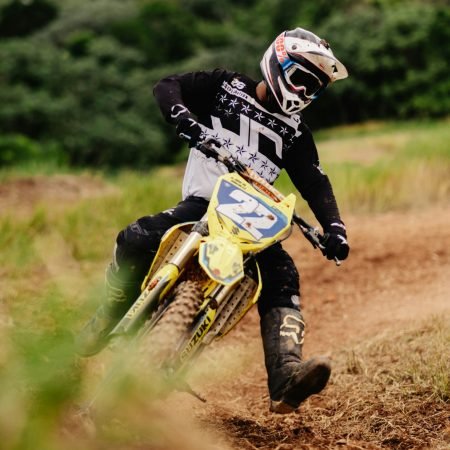
Trail-Brake into Corners
Trail-braking, keeping light brake pressure as you lean into a turn, helps control your speed and settles the suspension. Off-road, it keeps the front tire planted and adds stability through the corner.
The key is braking firmly before the corner, then easing off the lever as you tip in. Keep a little pressure as you start your turn so the bike doesn’t unload abruptly.
Practice Drill: On a broad, predictable curve, practice braking before the corner, then maintaining gentle front brake pressure as you lean. Gradually release as you exit.
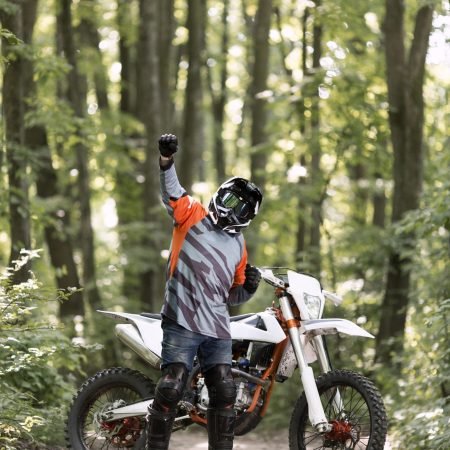
Wrapping Up
Building strong off-road skills takes time and repetition. You don’t have to master everything at once, but working on these six techniques will give you a solid foundation and more confidence in unpredictable conditions.
Pick one or two skills to focus on each ride. As you practice, you’ll find what once felt sketchy starts to feel natural and your riding will get a lot more rewarding.
Remember, no article or video replaces learning from experienced coaches. A professional off-road course can fast-track your progress with hands-on guidance and feedback you can’t always get alone. If you’re serious about leveling up, look into local or regional training programs. Plenty of instructors specialize in helping riders make a smooth transition from street to dirt.
To get started, check out our in-depth guide to adventure and off-road riding schools here:
Read More: Top 10 Off-Road Motorcycle Training Schools in the U.S. for Adventure Riders
With some dedication and the right mindset, you’ll discover that riding off-road isn’t just an upgrade, it’s an entirely new way to experience freedom on two wheels.
-Kevin Cave
